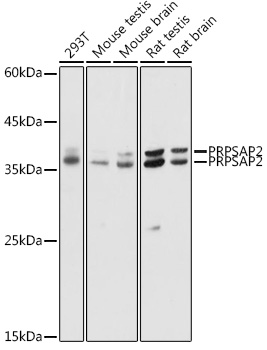PRPSAP2 antibody [N1C3]
GTX107648
ApplicationsImmunoFluorescence, Western Blot, ImmunoCytoChemistry, ImmunoHistoChemistry, ImmunoHistoChemistry Paraffin
Product group Antibodies
TargetPRPSAP2
Overview
- SupplierGeneTex
- Product NamePRPSAP2 antibody [N1C3]
- Delivery Days Customer9
- Application Supplier NoteWB: 1:500-1:3000. ICC/IF: 1:100-1:1000. IHC-P: 1:100-1:1000. *Optimal dilutions/concentrations should be determined by the researcher.Not tested in other applications.
- ApplicationsImmunoFluorescence, Western Blot, ImmunoCytoChemistry, ImmunoHistoChemistry, ImmunoHistoChemistry Paraffin
- CertificationResearch Use Only
- ClonalityPolyclonal
- Concentration1 mg/ml
- ConjugateUnconjugated
- Gene ID5636
- Target namePRPSAP2
- Target descriptionphosphoribosyl pyrophosphate synthetase associated protein 2
- Target synonymsPAP41, phosphoribosyl pyrophosphate synthase-associated protein 2, 41 kDa phosphoribosypyrophosphate synthetase-associated protein, PRPP synthase-associated protein 2
- HostRabbit
- IsotypeIgG
- Protein IDO60256
- Protein NamePhosphoribosyl pyrophosphate synthase-associated protein 2
- Scientific DescriptionThe enzyme phosphoribosylpyrophosphate synthetase (PRS) catalyzes the formation of phosphoribosylpyrophosphate which is a substrate for synthesis of purine and pyrimidine nucleotides, histidine, tryptophan and NAD. PRS exists as a complex with two catalytic subunits and two associated subunits. This gene encodes a non-catalytic associated subunit of PRS. [provided by RefSeq]
- Storage Instruction-20°C or -80°C,2°C to 8°C
- UNSPSC12352203
References
- Wu Y, Tan X, Liu P, et al. ITGA6 and RPSA synergistically promote pancreatic cancer invasion and metastasis via PI3K and MAPK signaling pathways. Exp Cell Res. 2019,379(1):30-47. doi: 10.1016/j.yexcr.2019.03.022Read this paper


![FACS analysis of HEK293T cells transfected with either PRPSAP2 plasmid(Red) or empty vector control plasmid(Blue) using GTX83790 PRPSAP2 antibody [1E3].](https://www.genetex.com/upload/website/prouct_img/normal/GTX83790/GTX83790_183_FACS_w_23061420_186.webp)




